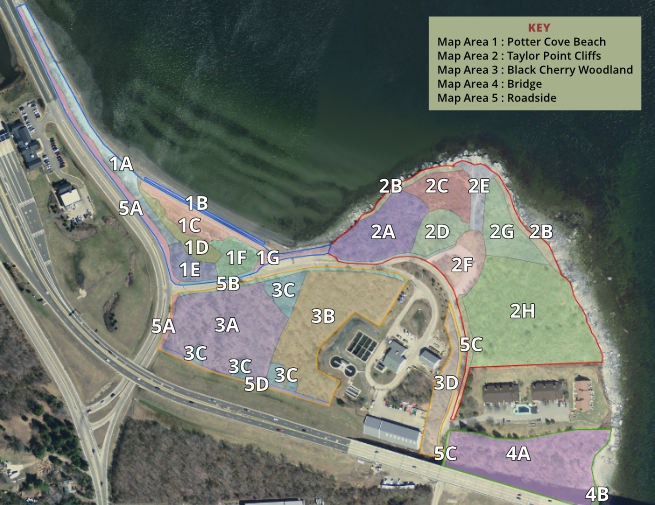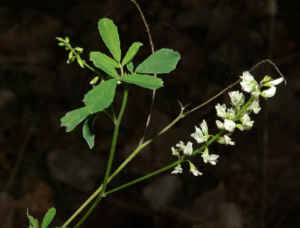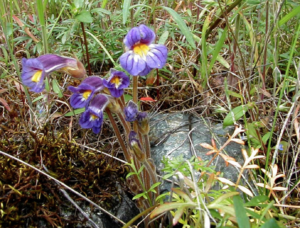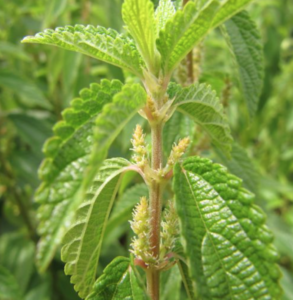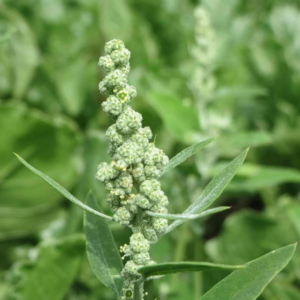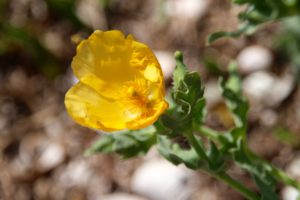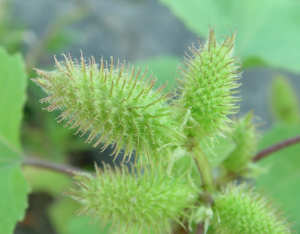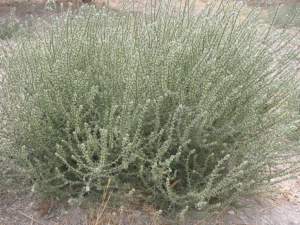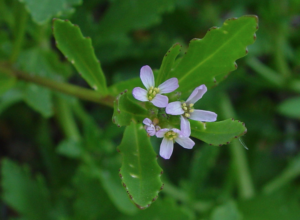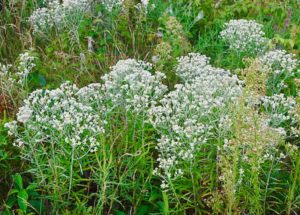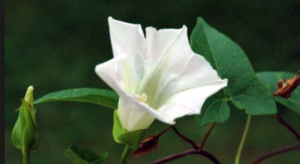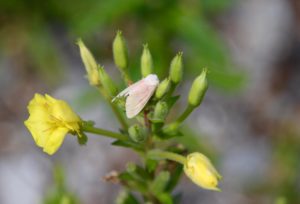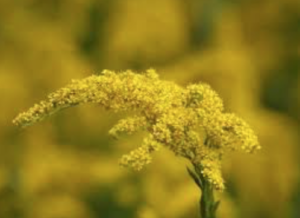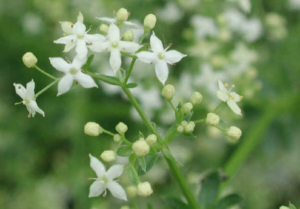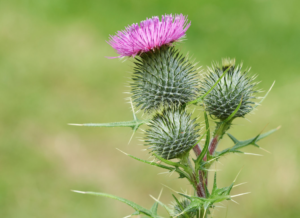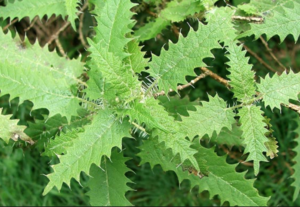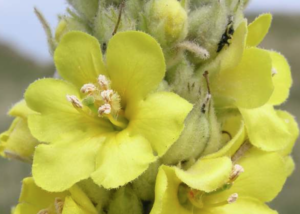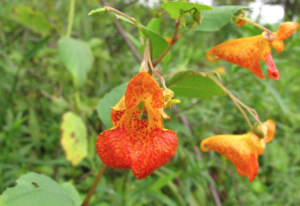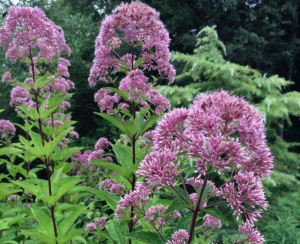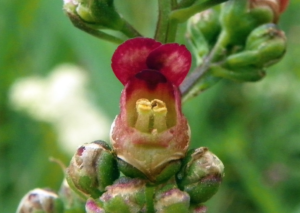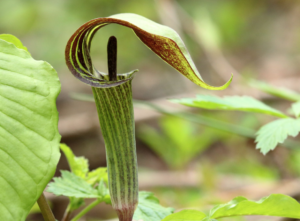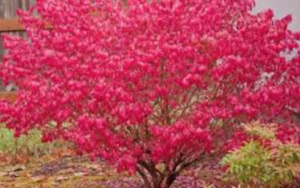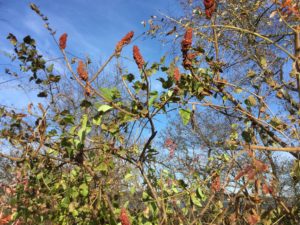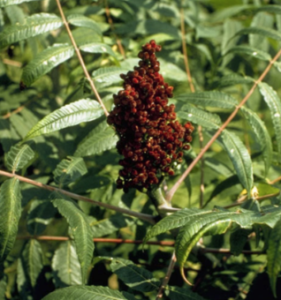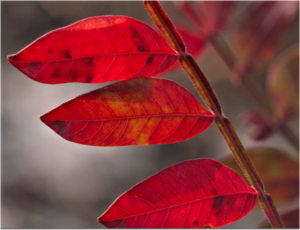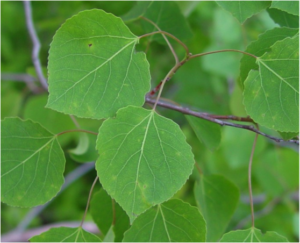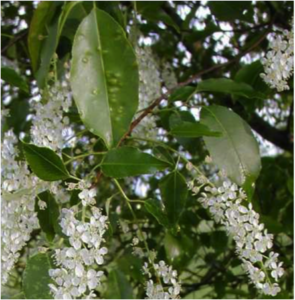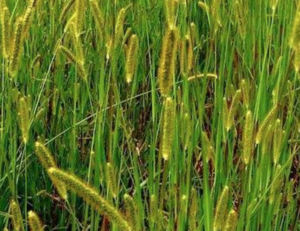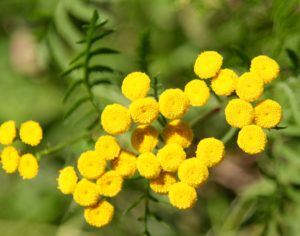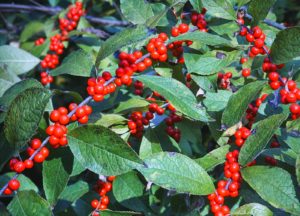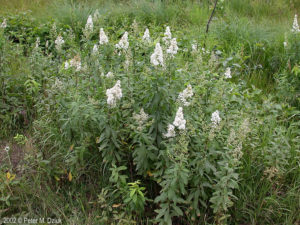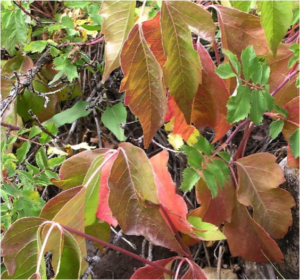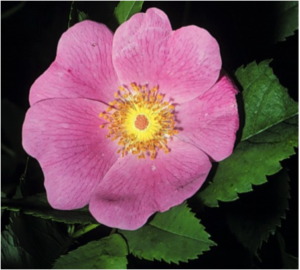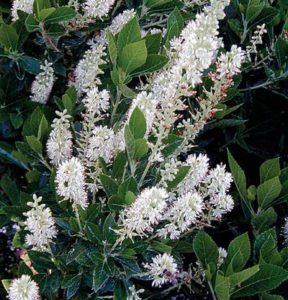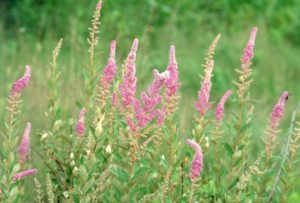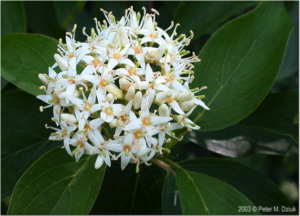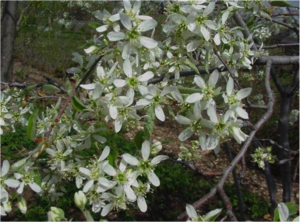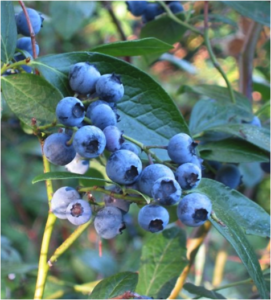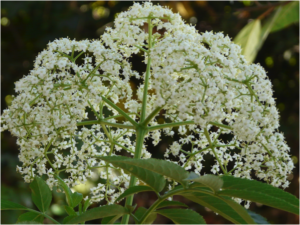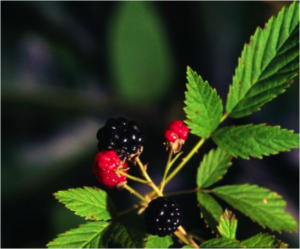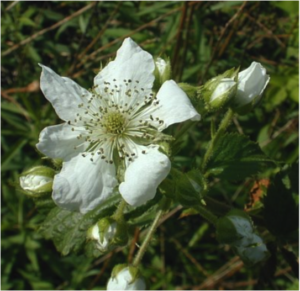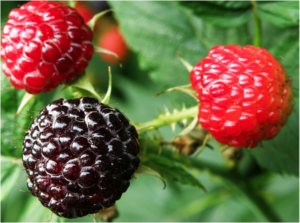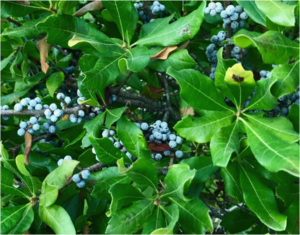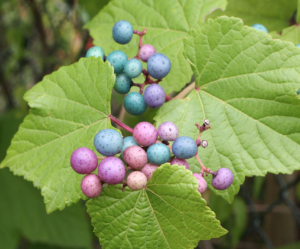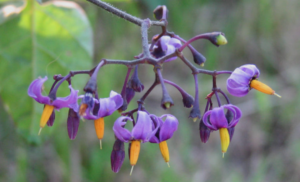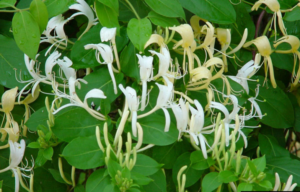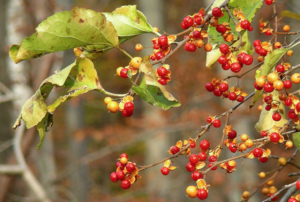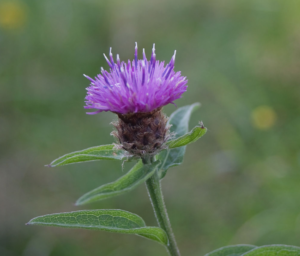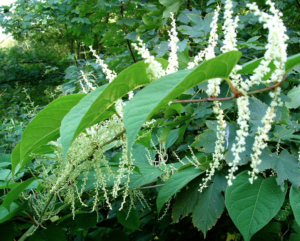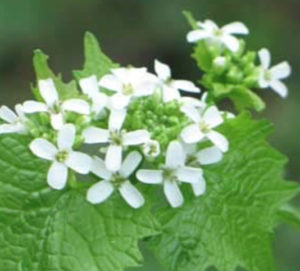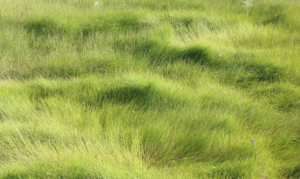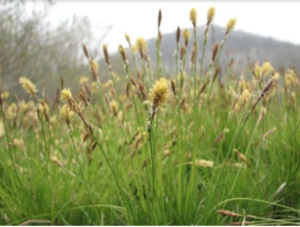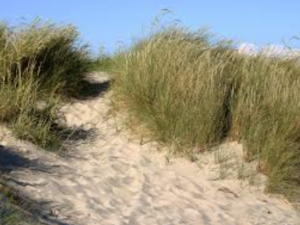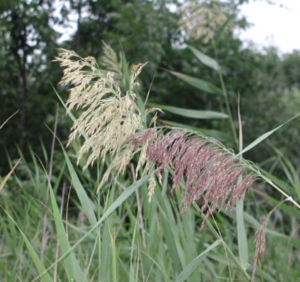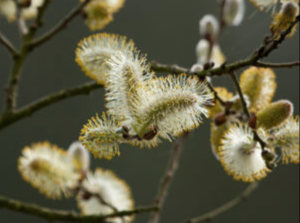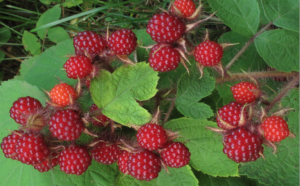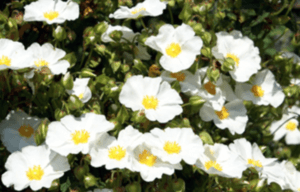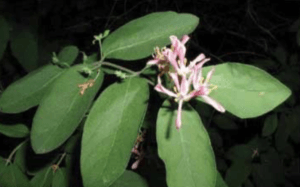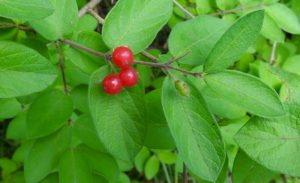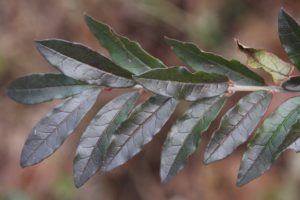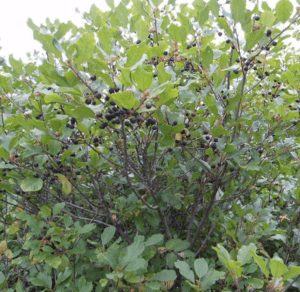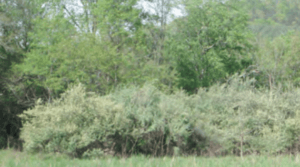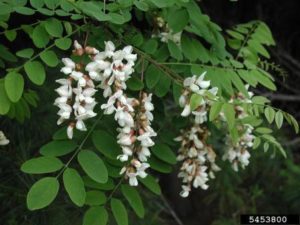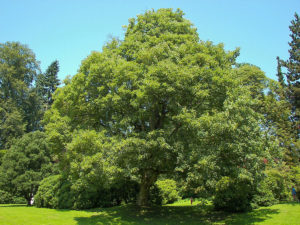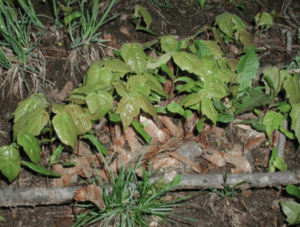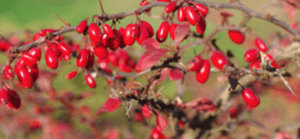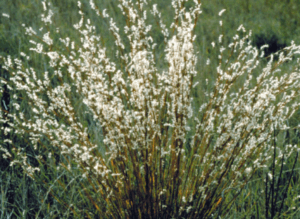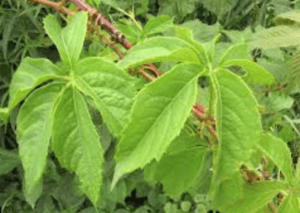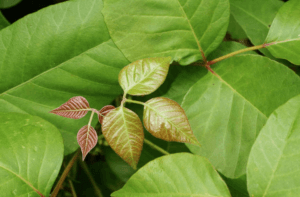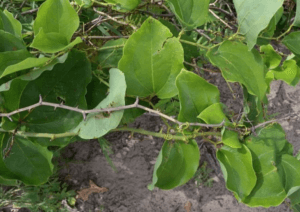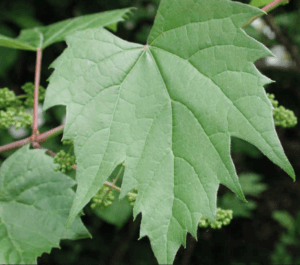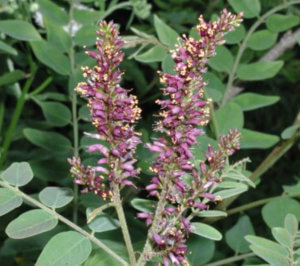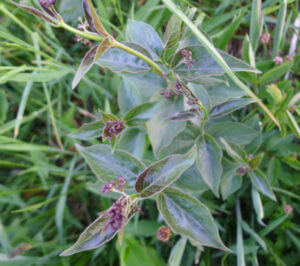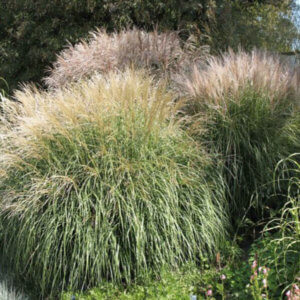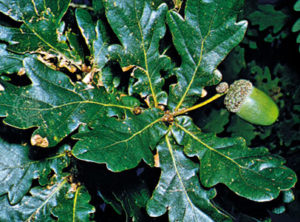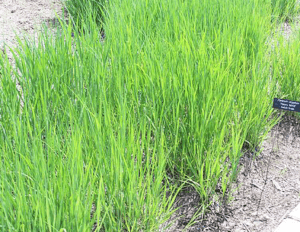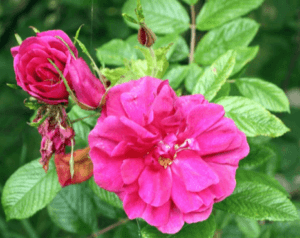Ecological Considerations: Melilotus alba, commonly known as White Sweet Clover is native to Europe and Asia. In the 1600s it was introduced to North America and used for cattle forage. Now widespread throughout Canada and the United States, it has become invasive and can outcompete native plant species. It thrives in disturbed areas and often is found… read more
One-flowered broom-rape
Ecological Considerations: Orobanche uniflora, commonly known as One-Flowered Broom-Rape is an annual, parasitic plant. One plant produces up to five flowering stalks, each of which bears a single, fragrant, white-to-lavender flower with a bilabiate corolla and no bractlets. The stems are covered with glandular hairs. The calyx of the flower is cleft deeply into five subequal… read more
Small-Spiked False Nettle
Ecological Considerations: Boehmeria cylindrica, commonly known as Small-Spiked False Nettle is a perennial plant that generally grows about 2-3′ tall, branching occasionally. This member of the Nettle family does not have stinging hairs. Its stems are light green, 4-angled or round. Its leaves are usually opposite along the stems, but sometimes they are alternate, and are… read more
Lamb’s Quarters
Ecological Considerations: Chenopodium album, commonly known as Lambs Quarters, is a summer annual, usually blooming from mid-summer through the fall. It usually grows to about 4 feet high. Lambs Quarters looks dusty from a distance owing to the white coating on the leaves. When it is moist, water beads up and runs off. The leaves resemble the… read more
Horn Poppy
Ecological Considerations: Glaucium flavum, commonly known as Horn Poppy is an herbaceous plant, usually biennial, that is only found on the seashore, never inland. It grows well on shingle beaches and cliffs and dunes reaching heights of one to three feet tall. The bright yellow flowers of the Horn Poppy are about three inches across. The… read more
Beach Clotbur
Ecological Considerations: Xanthium strumarium, commonly known as Beach Clotbur is a summer annual that grows to about 2-4 feet tall. It is branched, except for short side stems developing from the leaf axils. The stems are round or slightly ribbed and often are speckled with purple and have short white hairs scattered across the surface.… read more
Common Saltwort
Ecological Considerations: Salsola kali, or Common Saltwort is a member of the goosefoot or beet family. Common Saltwort is a summer shade-intolerant annual that can grow from one foot to two feet high and higher. It is a bushy plant and it reproduces by seed. The stems of the young Common Saltwort plants have stems with red or… read more
Sea Rocket
Ecological Considerations: Cakile edentula, commonly known as Sea Rocket, is a succulent, tap-rooted annual plant with tangy edible leaves that grows as a short shrub primarily on beaches and dunes. A member of the mustard family, Sea Rocket grows about 6 to 20 inches high and larger specimens can grow as wide as they grow tall. Preferring well… read more
Sweet Everlasting
Ecological Considerations: Gnaphalium obtusifolium, commonly known as Sweet Everlasting, is an herbaceous plant that primarily grows as an annual. In some cases it may behave as a biennial, growing a low rosette of fuzzy leaves the first growing season and then blooming in the second season. It generally measures one to two in height and is most… read more
Hedge Bindweed
Ecological Considerations: Calystegia sepium, commonly known as Hedge Bindweed is a perennial herbaceous vine that grows up to 10′ long, often climbing over other plants, shrubs, and fences. The twining stems are light green to red, with alternate leaves sparsely to moderately distributed along the stems. The leaves are about 2½-5″ long and 1-2″ across and… read more
Common Evening Primrose
Ecological Considerations: Oenothera biennis, commonly known as Common Evening Primrose, is a biennial, herbaceous plant distinguished by the fact that its bright yellow flowers remain partially to fully closed during the day and open in the evening. The flowers will remain open longer on cloudy days. Common Evening Primrose blooms from June to October. Its flowers… read more
Seaside Goldenrod
Ecological Considerations: Solidago sempervirens, commonly known as Seaside Goldenrod, is a late-flowering, short-day perennial that may grow up to 6 or even 8 feet tall. It blooms from August through October, producing terminal flowering heads with densely clustered spikes of bright yellow flowers. After blooming, flower clusters mature into seed heads filled with fuzzy, nut-like fruit… read more
Wild Madder
Ecological Considerations: Galium mollugo, commonly known as Wild Madder or White Bedstraw, is a herbaceous annual plant that grows from six inches to three or even four feet tall. Is distinguished by whorls of six to eight leaves and hairless vine-like stems.The leaf blade has no lobes or teeth. Its stems are square and grow… read more
Bull Thistle
Ecological Considerations: Ciasium vulgare is a tall biennial or short-lived monocarpic thistle that forms a rosette of leaves and a taproot up to two feet long in the first year, and a flowering stem, three to five feet tall in the second year. The stem is winged, with numerous longitudinal spine-tipped wings along its full length. The… read more
Stinging Nettle
Ecological Considerations: Urtica dioica is a perennial flowering plant. It can grow three to seven feet tall in the summer and generally dies down to the ground in winter. Its soft, green leaves are 1 to 6 in long and are borne oppositely on an erect, wiry, occasionally squarish, usually hairy, green stem. The greenish… read more
Mullein
Ecological Considerations: Verbascum thapsus, commonly known as Mullein or Great Mullein, is a hairy, biennial herbaceous plant. A basal rosette of large furry leaves and a substantial crown are produced in the first year. In its second year it sends up a single erect flowering stem that can bolt to to six feet high or more. The rod-like… read more
Jewelweed
Ecological Considerations: Impatiens capensis, commonly known as Jewelweed or Spotted Touch-Me-Not, is a self-seeding annual herbaceous plant that grows 3 to 5 feet tall. The flowers are orange (or sometimes yellow) with a three-lobed corolla; one of the calyx lobes is colored similarly to the corolla and forms a hooked conical nectar spur (tubular elongations of petals and… read more
Wild Radish
Ecological Considerations: Raphanus raphanistrum, commonly known as Wild Radish, is a member of the mustard family (Brassicaceae). Wild Radish grows to heights of one to two feet and occurs as an annual or a biennial plant. It has a single fibrous taproot which is similar to that of the cultivated radish but smaller. The plant’s basal… read more
Hollow Joe-Pye Weed
Ecological Considerations: Eutrochium fistulosum, commonly known as Hollow Joe-Pye Weed, is a tall, flowering, herbaceous perennial in the sunflower family. It typically grows from four to seven feet high and features coarsely-serrated, lance-shaped, dark green leaves that grow in whorls of four to seven on sturdy green hollow stems. Tiny, vanilla-scented, dull dusky rose flowers grow… read more
Woodland Figwort
Ecological Considerations: Scrophularia nodosa, commonly known as Woodland Figwort, is a tall, perennial, herbaceous plant that grows in moist woodlands and disturbed areas, in full sun or in partial shade. Its thick square succulent stems grow upright anywhere from 12 inches to as high as 60 inches tall. Its root stock is horizontal and… read more
Jack-in-the-Pulpit
Ecological Considerations: Arisaema triphyllum is a herbaceous perennial that grows one to two feet high and is characterized by three-parted leaves and flowers growing within a spadix ( essentially a spike inflorescence which has small flowers growing on a fleshy stem), that is covered by a hood or spathe. The inflorescences are irregular in shape and commonly… read more
Burning Bush
Ecological Considerations: Euonymus atropurpurea is a low branching deciduous shrub that usually grows to a height of about 6 feet but which can grow as high as 20 feet if conditions favor it. A species of shrub in the bittersweet family, Burning Bush is often found in woods and thickets or along roadsides and disturbed… read more
Staghorn Sumac
Ecological Considerations: Rhus typhina, commonly called Staghorn Sumac, is an open, colony-forming shrub that typically grows 15-25’ tall. It is particularly noted for the reddish-brown hairs that cover the young branchlets in somewhat the same way that velvet covers the horns of a stag (male deer), hence the common name. It is also noted… read more
Smooth Sumac
Ecological Considerations: Rhus glabra, commonly known as smooth sumac, is a native, colony-forming, deciduous shrub that occurs on fields, abandoned farmland, clearings and along roads. Smooth sumac forms thickets from root suckers. The stems and branches are hairless and covered with a whitish waxy coating. The leaves are alternate and pinnately compound (3-5 dm… read more
Winged Sumac
Ecological Considerations: Rhus copallinum, commonly known as Winged sumac, is a native, deciduous, colony-forming large shrub (a woody plant with several stems growing from the base) that rarely exceeds 10 feet. It has alternate, compound leaves, 16-24 inches long, with a winged leafstalk. The leaflets are narrowed or rounded at the base and sharply pointed… read more
Quaking Aspen
Ecological Considerations: Populus tremuloides, commonly called Quaking Aspen, a member of the Willow family, is perhaps most noted for its beautiful white bark, its deep green foliage that quakes in the slightest breeze and its golden yellow fall foliage color. It is a medium sized deciduous tree that typically grows 20-50’ tall with a narrow,… read more
Black Cherry
Ecological Considerations: Prunus serotina, commonly called Black Cherry, is a 25 – 110 foot tall deciduous tree, distinctly conical in youth. When open-grown it becomes oval-headed with spreading, pendulous limbs and arching branches. Crowded trees grow tall and slender. Black Cherry leaves are shiny on the upper surface; the leaf blade is oblong with a long pointed tip and tapering base; leaf margins are finely serrate. White flowers are held in drooping racemes after the… read more
Yellow Foxtail
Ecological Considerations: Setaria pumila is a summer annual grass that grows about 1 – 3 feet high. Its mostly hairless stems range from green to purple-tinged in color. The inflorescence is a stiff, cylindrical bundle of spikelets 2 to 15 centimeters long with short, blunt bristles. The panicle may appear yellow or yellow-tinged. The flowers have… read more
Tansy
Ecological Considerations:Tanacelum vulgare is a hardy perennial flowering herbaceous plant in the aster family. Tansy flowers tolerate average, somewhat dry soils (but not wet soils) and will grow in either full sun or partial shade. It is often found growing along roadsides. Its yellow flower is round, flat-topped, and button-like, growing in terminal clusters and blooming from mid-to-late summer. Tansy… read more
Common Winterberry
Ecological Considerations: Ilex verticillata is an erect moderate sized shrub, growing to heights of 5 to 15 feet tall. The smooth bark of winterberry is gray to blackish, with knobby lenticels. The dense branches of this shrub grow in a zigzag pattern with an upright spreading crown. The twigs are slender, with gray to… read more
White Meadowsweet
Ecological Considerations: Spiraea alba, commonly called Meadowsweet, is a mounded, 1-6 ft. shrub with numerous, fine-textured, erect, unbranched stems. The bark is smooth, grayish to reddish brown eventually peeling off in fine strips.The leaves are alternate, simple, finely serrated, elliptical, 2 inches long, green above, paler below turning golden-yellow in fall. Tiny white or… read more
Western Poison Ivy
Ecological Considerations: Toxicodendron rydbergii is an erect native perennial shrub that produces a woody stem, usually unbranched. Unlike the Eastern Poison Ivy it does not have aerial roots and does not climb. However, a robust plant can produce a stout woody stem reaching several feet in the air. Leaves are alternate and divided into 3… read more
Virginia Rose
Ecological Considerations: Rosa virginiana, commonly known as Virginia rose, is an upright shrub growing between four to six feet tall. The glossy dark green foliage develops excellent yellow to red fall color. This species bears fragrant pink flowers that are two to three-inches in diameter and occur in clusters of five to eight. Virginia… read more
Coastal Sweet-Pepperbush
Ecological Considerations: Clethra alnifolia, commonly known as coastal sweet-pepperbush, is a large deciduous shrub that grows to 2.5 m tall. The bark is smooth, reddish- orange or gray in color, and 2 to 3 mm in diameter. Twigs are reddish-orange covered with dense white hairs. Leaves are alternate, simple, 5 to 8 cm long,… read more
Steeplebush
Ecological Considerations: Spiraea tomentosa, commonly known as Steeplebush, is 2-4′ tall, more or less erect shrub, and it is usually unbranched. The central stem is cylindrical, smooth, and brown; it is initially covered with woolly brown hairs, but later becomes hairless and woody. Alternate leaves are abundant along the stem; they are 1½–3″ long,… read more
Silky Dogwood
Ecological Considerations: Swida Amomum, commonly known as silky dogwood is a large native shrub, often 6-10 feet in height. The growth habit is upright rounded, but where stems are in contact with the ground, roots are formed. This behavior creates thickets. Young dogwoods have bright red stems in the fall, winter and early… read more
Shadbush
Ecological Considerations: Amelanchier canadensis, commonly called shadbush or serviceberry, is a deciduous, early-flowering, large shrub or small tree which typically grows 15-30′ tall. Features showy, 5-petaled, slightly fragrant, white flowers in drooping clusters which appear before the leaves emerge in early spring. Finely toothed, elliptic, medium to dark green leaves (1-3″ long) change to… read more
Highbush Blueberry
Ecological Considerations: Vaccinium corymbosum, commonly known as Highbush Blueberry, is in the Heath family (Ericaceae). It is a native shrub that grows 6 to 12 feet tall, is crown-forming, forms dense colonies, and has warty and yellow-green, glabrous twigs. It’s leaves are deciduous, alternate, simple, narrow to broadly elliptic or ovate, 2-3 inches long.… read more
Black Elderberry
Ecological Considerations: The elderberry is an erect, thicket-forming, somewhat woody shrub, 4-12 feet tall, with smooth yellowish-gray branchlets and white pith. Compound leaves are set oppositely in pairs in a feather-like arrangement. The leaf surface is bright green. The oval to lance-shaped leaflets are up to 6″ long and 2 1/2″ wide, with finely… read more
Dewberry
Ecological Considerations: The dewberries are a group of species in the genus Rubus, section Rubus, closely related to the blackberries. They are small trailing (rather than upright or high-arching) native brambles with aggregate fruits, reminiscent of the raspberry, but are usually purple to black instead of red. Unlike many other Rubus species, dewberries have separate male and female plants This woody vine produces stems up… read more
Common Blackberry
Ecological Considerations: Rubus allegheniensis, commonly called Common Blackberry, is a native woody shrub that forms canes that are initially erect, but often bend downward to re-root in the ground. These canes actively grow and form leaves during the first year, and develop fruits in the form of drupes during the second year, after which they… read more
Black Raspberry
Ecological Considerations: Rubus occidentalis, commonly called Black Raspberry, is a perennial shrub that produces little-branched canes up to 6′ long during the first year. These canes are initially erect, but they eventually arch sideways and downward. First-year canes are vegetative and do not produce flowers and fruit. They are initially green, hairless, and glaucous,… read more
Bayberry
Ecological Considerations: Morella pensylvanica, commonly known as Bayberry, is an upright shrub, which is typically 5 to 8 feet in height, except on sand dunes and poor quality sites. The species has male and female plants. Flowers occur in early spring and are not showy. Female plants produce numerous small, blue-grey, waxy round fruit… read more
Smooth Arrowwood
Ecological Considerations: Viburnum dentatum, commonly called Arrowwood or Smooth Arrowwood, is a native shrub growing 3-9 feet tall and spreading sometimes up to 8 feet. The plant’s arching branches form an overall rounded crown. Its twigs are slender, ridged and angled. Its leaves are deciduous, opposite, simple, oval to oblong, obovate (inversely egg-shaped), or… read more
Porcelain-berry
Ecological Considerations: Ampelopsis glandulosa is a deciduous, woody vine that climbs to heights of more than 20 ft. and closely resembles native species of grape. These branched tendril-bearing, non-adhesive woody vines have lenticels and white piths that are continuous across the nodes. The Ieaves are alternate, broadly ovate with a heart-shaped base, palmately 3-5 lobed… read more
Climbing Nightshade
Ecological Considerations: Solanum dulcamara is a semi-woody perennial vine or scrambling shrub with slender stems that can reach up to 6.6 feet. The plant’s leaves are dark-green to purplish, petiolate, alternate, 3 lobed (upper part of the stem), acuminate and up to 3.1 inch long. It’s flowering occurs in May to November, when… read more
Japanese Honeysuckle
Ecological Considerations: Japanese honeysuckle is a woody perennial vine that climbs by twisting its stems around vertical structures, including limbs and trunks of shrubs and small trees. The vines can climb 80 feet high or more and will form a thick covering over trees, shrubs and ground cover species. The leaves are… read more
Asian Bittersweet
Ecological Considerations: Asian Bittersweet is a woody, perennial vine with thin, spindly, silver to reddish brown bark. The vines of this bittersweet twist around the trunks of nearby trees or shrubs and can grow to 100 feet. The leaves are alternate, toothed, and teardrop-shaped to round with a pointed tip. The flowers… read more
Black Knapweed
Ecological Considerations: Black Knapweed is a tall flowering thistle-like perennial plant that can grow from 1-3 feet high. A member of the daisy family, its leaves grow up to 10 inches long, and are usually deeply lobed, and hairy. The lower leaves are stalked. The upper ones are stalkless. The head bears many small… read more
Japanese Knotweed
Ecological Considerations: Fallopia japonica is an herbaceous shrub that can grow from 3 to10 feet in height. It has an extensive network of rhizomes that may extend laterally up to 65 ft. The stem is smooth, stout, and swollen at joints where the leaf meets the stem. It resembles the hollow stalks of bamboo. Its… read more
Garlic Mustard
Ecological Considerations: Garlic Mustard is a cool season biennial herb that grows a deep, thin, white taproot that smells like horseradish. It has stalked, coarsely toothed leaves that give off an odor of garlic when crushed. In their first year, plants appear as a rosette of green leaves close to the ground. The rosettes… read more
Saltmarsh Hay
Ecological Considerations: Spartina patens is a slender, wiry grass found along the upper reaches of slain to brackish coastal salt marshes, often where it is covered at times by high tides and along sandy beaches and low dunes, tidal flats and marsh ridges. It grows in thick mats 1 to 2 feet high,… read more
Early Sedge
Ecological Considerations: Early Sedge is a low sedge characterized by soft, delicate, arching, semi-evergreen leaves which are green in summer and turn tannish in winter. It typically grows in a clump up to 8″ tall and is semi-evergreen in moderately cold winter climates. Early Sedge grows especially well in upland woodlands, thinly wooded bluffs,… read more
American Beachgrass
Ecological Considerations: American beachgrass, a hardy perennial grass native to eastern North America, is known for its ability to grow on sand dunes and to aid in dune stabilization along New England’s coast. Beach grass grows well in areas characterized by shifting sands and areas exposed to high winds, particularly where foredunes form along… read more
Common Reed
Ecological Considerations: Phragmites australis is a stout, warm-season, perennial grass that can grow as high as 12 – 15 ft, often extending in vast thick expanses. The stems of Phragmites are smooth, upright, rigid, and hollow. Its leaves are gray-green, contrasting with long white hairs that grow from the leaf-sheath junction. The inflorescence is… read more
Gray Willow
Ecological Considerations: Salix cinerea is a is a slender tree-like shrub that can reach heights of 30 feet. It is generally branched from the base but also can form a single trunk. Its leaves are shiny on the upper surface, bearing soft grey hairs on the underside. Its distinctive catkins, or flowers, appear before… read more
Wine Raspberry
Ecological Considerations: Wine Raspberry, or Wineberry is a member of the raspberry and blackberry family and grows as tall upright canes. The canes are covered with red hairs and spines, which give them a reddish color when viewed from afar. The canes may grow as high as 9 feet. Wineberry grows especially well in… read more
Multiflora Rose
Ecological Considerations: Rosa multiflora is a thorny, perennial shrub with arching stems (canes). In early summer clusters of showy, fragrant, white to pink flowers emerge, giving way, as the summer progresses, to small bright red fruits, or rose hips. The rose hips remain on the plant through the winter. Multiflora rose is tolerant… read more
Pretty Honeysuckle
Ecological Considerations: Lonicera x bella is hybrid cross between Tatarian and Morrow’s honeysuckles. It is a deciduous upright shrub that spreads aggressively, forms dense thickets, and grows as high as 10 feet tall or higher. It has a shallow root system. The flowers are usually pink, often fading to yellow. They are… read more
Morrow’s Honeysuckle
Ecological Considerations: Lonicera morrowii is a woody, perennial shrub, with hollow stems. It reaches about 8 feet in height. Its flowers, which bloom in early spring, are paired and usually white, fading to yellow through the season. Its fruits are red berries, also borne in pairs. The berries appear in mid-summer and… read more
Border Privet
Ecological Considerations: Border Privet grows as a shade-tolerant, tall shrub or small tree. It can reach heights of 30 feet or taller, often in dense thickets along forest edges, in disturbed areas, and across rights-of-way. It has smooth bark and slender twigs. Border Privet does not favor dry soils and it is shade tolerant.… read more
Glossy Buckthorn
Ecological Considerations: Glossy buckthorn is a shrub or small tree that can grow as high as 20 feet. It is both sun and shade tolerant and grows in a wide variety of soil and moisture conditions, from wet to very dry. It often thrives in pastures, along fence rows, by roadsides, in wetlands, and… read more
Autumn Olive
Ecological Considerations: Elaeagnus umbellata is a deciduous shrub that grows from 3 to 25 feet high. Its leaves are silvery green on the undersides and it has brown or gray-brown bark, with scattered thorns. Its flowers are fragrant and have 4 petals and stamens, are cream to light yellow in color. In the fall… read more
Black Locust
Ecological Considerations: Black Locust is a fast-growing tree that can grow as high as 100 feet. The diameter of its trunk can grow up to 3 and a half feet across. The bark of the tree is gray to dark brown in color is deeply furrowed. Seedlings and sprouts grow rapidly and are easily… read more
Sycamore Maple
Ecological Considerations: Acer pseudoplatanus is a tall, deciduous, broad-leaved tree that can grow more than 100 feet tall. Tolerant of wind, urban pollution, salt spray, and low summer temperatures, it grows well along the coast. It also adapts well to extreme soil conditions. The bark of the tree is smooth and gray when the… read more
Norway Maple
Ecological Considerations: Norway Maples commonly grow 40-60 feet high, and can reach heights of 100 feet. The tree’s bark is gray and regularly and shallowly grooved. The leaves are usually green in summer and yellow in the fall. The flowers appear in April and May and are yellow-green. The fruits are samaras that are… read more
Japanese Barberry
Ecological Considerations: Berberis thunbergii is a spiny shrub that grows 2 to 8 feet high in dense thickets. The branches are brown, and have sharp spines. The leaves are small and green, bluish-green, or dark reddish purple. It has pale yellow flowers that hang in umbrella-shaped clusters. The fruits are bright red berries growing… read more
Little Bluestem
Ecological Considerations: Schizachyrium scoparium is a tufted bunchgrass that forms dense mounds rising 18 to 24 inches in height and extending in clumps that stretch up to a foot in diameter. It begins growth in late spring after cool-season species have already developed and its slender, blue-green stems generally appear in August. In September… read more
Virginia Creeper
Ecological Considerations: Parthenocissus quinquefolia is a fast-growing, deciduous, climbing vine that has tendrils with adhesive tips that adhere to trees and other climbed surfaces. It can grow, given a suitable substrate, easily 30 to 50 feet. Its leaves have a distinctive five-leaflet structure and a toothed margin. They are green in spring and summer… read more
Poison Ivy
Ecological Considerations: Toxicodendron radicans is a poisonous, robust, woody flowering vine that grows is a wide variety of habitats. It often grows along the ground. It also climbs up trees or posts or other vertical structures, attaching via a system of aerial rootlets, and poison ivy also appears often in a shrub-like form, growing… read more
Greenbrier
Ecological Considerations: Smilax rotundifolia is a woody vine that grows up to twenty feet long and climbs trees and other vegetation or surfaces. Many of its stems, though not all, have sharp black-tipped stout thorns that extend up to 1/3 inch occurring along the stems. Its glossy green circular or heart-shaped leaves are… read more
Fox Grape
Category: Native, Vine Ecological Considerations: Vitis labrusca is a climbing, branching woody vine that generally grows 10 – 40 feet long. The trunk bark is brown and shredded. Its leaves grow about 4 – 8 inches wide are widely spaced along the shoots and stems. The upper surface of the leaf is smooth and green… read more
False Indigo
Ecological Considerations: Amorpha fruiticosa is a medium-sized shrub that can grow up to about 10 feet tall. Its branches are firm and woody. Its twigs are green and hairy. The leaflets are 1 to 2 inches long, resinous, dotted and hairy. In New England it usually grows somewhat lower. It has distinctive violet flowers… read more
Black Swallowwort
Ecological Considerations: General: Black Swallowwort is a perennial, twining herbaceous vine that can reach 6 ft in length. The leaves are oval shaped with pointed tips and occur in pairs along the stem. The small five-petaled star shaped flowers are dark purple to almost black with white hairs, and are borne in clusters. The… read more
Chinese Silvergrass
Ecological Considerations: Miscanthus sinensis is a highly variable robust perennial grass that grows commonly in large clumps and can reach 12 ft. high. The clumps or bunches can grow as wide as 3 feet. Chinese Silvergrass propagates primarily by seed. Its branches are flexible and spread or droop. The leaves are elongate and can… read more
English Oak
Ecological Considerations: Quercus robur is a tree with a wide spreading crown, a short sturdy trunk, and deeply fissured gray brown bark. It can grow to heights of 50 to 60 feet and bears a broad-spreading, rounded crown. It has small deciduous leaves with 3-7 pairs of rounded lobes, and extremely short petioles. Their… read more
Switchgrass
Ecological Considerations: Panicum virgatum or switch panicgrass is a hardy, adaptable, deep-rooted, perennial grass that prefers full sun, but will tolerate partial shade. It grows between 3 to 7 feet high and does well in both dry or moist conditions. Its flowers have a well-developed panicle, often growing up to 25 inches long, and… read more
Beach Rose
Ecological Considerations: Rosa rugosa is a shrub with many stems and extensive, woody rhizomes. It is commonly found in coastal habitats. Its stems and branches have fine thorns. The plant can grow to 5 or 6 feet tall, often in very dense thickets. Rosa rugosa blossoms are generally two to three inches in diameter… read more
